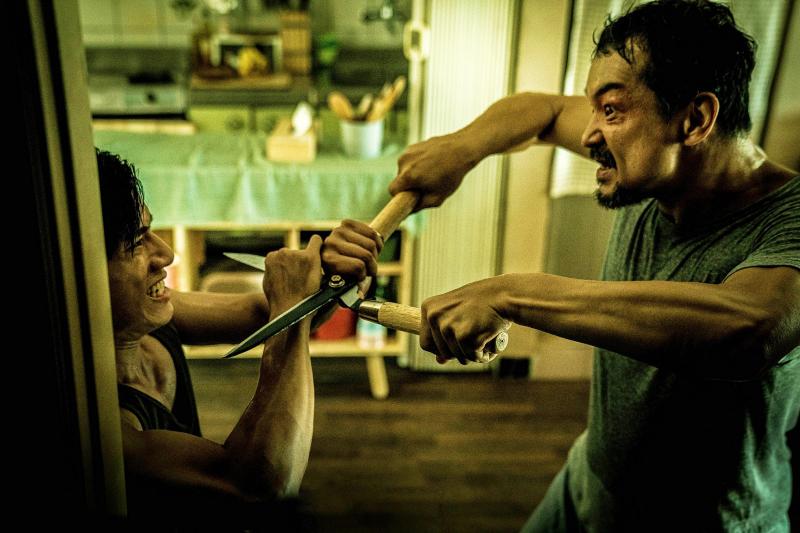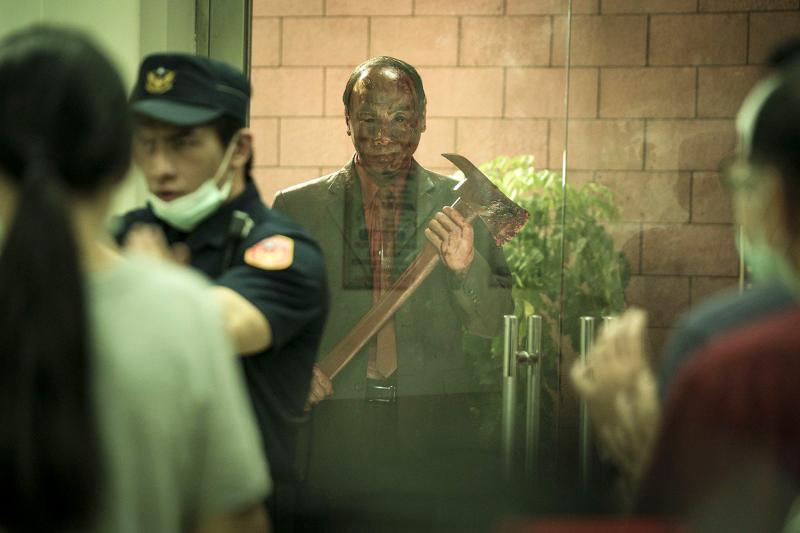If you’re squeamish about intentionally campy, senselessly gory zombie-style bloodfests, stay away from this film.
This reviewer is no fan of the genre, but somehow, between the smooth production, excellent death metal-meets Taiwanese temple music soundtrack, fast paced action and not-so-subtle digs at the government and humanity, The Sadness (哭悲) proved to be mildly entertaining.
The social parody is not as relentless and biting as last August’s Get The Hell Out (逃出立法院), where the nation’s entire legislative body transforms into zombies, but that one was somewhat bogged down by very specific Taiwanese cultural references that could only be appreciated by a familiarity with the nation’s pop culture and sociopolitical events. You don’t need to know that much to understand The Sadness, just sit back and enjoy the crazy rampages and flying guts.

Photo courtesy of iFilm
Set in an anti-Taiwan where the government has chosen to downplay and ignore the potential effects of an ongoing “Alvin Virus” pandemic despite warnings from leading virologists, the virus suddenly mutates and starts turning people into sadistic, bloodthirsty, cannibalistic and lustful maniacs.
What’s interesting here is that the infected still retain their sentience and control over their bodies. They’ve just completely given into their worst tendencies and desires — which makes them way creepier and more dangerous than the typical brainless, bumbling zombie. Even worse, a virologist suggests at one point that they may still be aware of what they’re doing, they just can’t control it anymore — it’s like fighting the urge to blink, he says.
The film opens with lead couple Jack (Berant Chu 朱軒洋) and Kat (Regina,雷嘉納), who are separated when Kat heads to her job in Taipei and Jack stays in their cozy Keelung home. The violence erupts across Taiwan shortly after, and the two try to find each other amid the chaos. That’s about it to the plot (and their relationship) and there’s almost no character development or depth, but director Rob Jabbaz does a decent job in using extreme effects, eerie moods and disturbing dialogue and behavior to carry the film through.

Photo courtesy of iFilm
While Hollywood zombies have most aspects of their humanity removed as they commit their carnage, the infected lunatics here are driven by their all-too-human darker sides. For example, Kat’s primary pursuer (Wang Tzu-chiang, 王自強) is fixated on her since she rejected his advances earlier on the MRT. This is the common theme that emerges from the bloodbath and gives the viewers at least something to, um, chew on.
There’s not much acting skill needed to portray the terrorized and panicking “good guys” in such a film and the two leads do a satisfactory job (it’s Regina’s feature debut). And while some may complain that the behaviors of the infected are too crass and inappropriate, the point of the film is to exaggerate the vileness buried in our hearts.
Kudos to IF SFX Art Maker (覺藝工作室特效化妝) for the special effects (they also worked on Get The Hell Out among other movies). They’ve managed to even make the most extreme scenes look believable and not cheesy, which is something that could make or break the film.
This kind of film is not meant to make much logical sense, and although there are some questionable points, what’s presented is watchable enough. But shiny production, an intriguing concept and a willingness to go beyond what’s normally acceptable isn’t what makes a movie memorable. There’s tons of potential — and value — here, but the oversimplified plot and lack of attention to storytelling nuances and details is notable.

Exceptions to the rule are sometimes revealing. For a brief few years, there was an emerging ideological split between the Democratic Progressive Party (DPP) and Chinese Nationalist Party (KMT) that appeared to be pushing the DPP in a direction that would be considered more liberal, and the KMT more conservative. In the previous column, “The KMT-DPP’s bureaucrat-led developmental state” (Dec. 11, page 12), we examined how Taiwan’s democratic system developed, and how both the two main parties largely accepted a similar consensus on how Taiwan should be run domestically and did not split along the left-right lines more familiar in

As I finally slid into the warm embrace of the hot, clifftop pool, it was a serene moment of reflection. The sound of the river reflected off the cave walls, the white of our camping lights reflected off the dark, shimmering surface of the water, and I reflected on how fortunate I was to be here. After all, the beautiful walk through narrow canyons that had brought us here had been inaccessible for five years — and will be again soon. The day had started at the Huisun Forest Area (惠蓀林場), at the end of Nantou County Route 80, north and east

This month the government ordered a one-year block of Xiaohongshu (小紅書) or Rednote, a Chinese social media platform with more than 3 million users in Taiwan. The government pointed to widespread fraud activity on the platform, along with cybersecurity failures. Officials said that they had reached out to the company and asked it to change. However, they received no response. The pro-China parties, the Chinese Nationalist Party (KMT) and Taiwan People’s Party (TPP), immediately swung into action, denouncing the ban as an attack on free speech. This “free speech” claim was then echoed by the People’s Republic of China (PRC),

Specialty sandwiches loaded with the contents of an entire charcuterie board, overflowing with sauces, creams and all manner of creative add-ons, is perhaps one of the biggest global food trends of this year. From London to New York, lines form down the block for mortadella, burrata, pistachio and more stuffed between slices of fresh sourdough, rye or focaccia. To try the trend in Taipei, Munchies Mafia is for sure the spot — could this be the best sandwich in town? Carlos from Spain and Sergio from Mexico opened this spot just seven months ago. The two met working in the